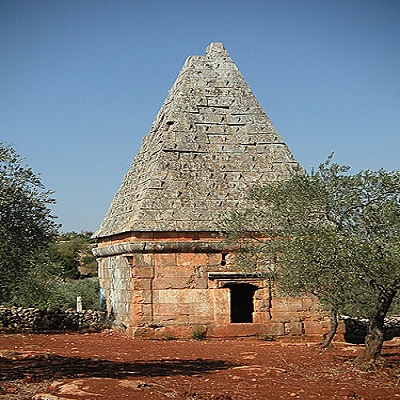Man had always thought of life after death, and peoples all round the world dedicated large portions of their thinking and, sometimes, of their wealth to prepare a good resting place for themselves after earthly life. The greatest achievements man had ever made in preparation for that purpose are the tomb Pyramids of alGiza which the Pharaohs built for themselves, and the pyramids of the Aztec civilization in Latin America. But these huge burial monuments were mostly built by great kings and queens in periods when their countries enjoyed a wealthy economy and a high degree of scientific progress. In later times peoples built great mausoleums for their leaders and beloved ones like Napoleon’s tomb in France and Taj Mahal in India.
These great tombs constituted an unusual architectural phenomenon narrating the story of a man who devoted himself to certain religious beliefs, mainly life after death, or in another meaning immortality of the spirit, not the body, which deceases and changes into a mere memory.
Peoples of lesser positions and importance than the pharaohs and great rulers received the same respect after their death but at a moderate level. One of the travelers who visited Idleb and saw the pyramid tombs said: “Dwellers of this region built luxurious houses to live in but did not forget to build magnificent tombs to rest in after their death”.
The phenomenon of pyramid tombs attracts attention for two reasons: First they conceal deep secrets which motivate us to reveal them and enhance our knowledge of the historical periods they were built in. Second, because they constitute one of the main pillars of cultural tourism due to the variation of their designs and shapes, add to that they can be found near settled places among farms and houses, as is the case in Idleb.
Syria, and Idleb Province in particular, has many examples of tombs built in the shape of pyramids for provincial rulers or clergies. These pyramid tombs can be found in Parisha, Serjila, Qalb Lozeh , alBara, Sarmada and alDana in the Orontes Valley. These tombs mostly belong to the Aramaic and Amorite periods. There are also pyramid tombs in Amrit at the Syrian Coast, in Apamea and in Bosra, Qanawat and Allajat which were built by the Nabateans. The only historical site which has no pyramid tombs in Syria is Palmyra.
The pyramid tombs of Idleb were built in the shape of towers of two parts, the lower one is a cubic base and the upper part a pyramid shape. The lower part is usually made of two chambers: The first has tunnels connected to sarcophaguses while the second is specified to the important person buried in the tomb, therefore it has a higher floor than the lower chamber.
 Pyramid tombs of Idleb are between 15 to 30m high, depending on the social and economic position of the person buried in the tomb. Most of these tombs lost substantial parts due to destruction and earthquakes, but their main elements can be identified easily.
Pyramid tombs of Idleb are between 15 to 30m high, depending on the social and economic position of the person buried in the tomb. Most of these tombs lost substantial parts due to destruction and earthquakes, but their main elements can be identified easily.
Latest information we have about these tombs is that they were built at the beginning of the second century AD with one level and a ceiling with stone teethed parameter at the four sides, like the three tombs of alBara, one of them represents the peak of decorative designs of the sixth century AD, and in Ma’arrat alShalf and in Koknaya. In Mt Parisha there are three pyramid tombs also, but the most preserved ones are in Mt alZawya in Has, Serjila and Baouda.
There are three intact pyramid tombs south west of alBara, one of them has a square base of 6m for each side and 2.5m high with a decorated ledge topped by four triangular walls built of big stones. The four walls meet at the peak of the pyramid in a unique shape.
The largest of these tombs has a square base with 9m for each side, but the pyramid part is partly destroyed. It has a decorative cordon at the entrance with herbal decorations. Inside the tomb there are five sarcophaguses. Tombs Similar to this one can be found in Kherbet Has, southern Dana and Baouda.
In the northern part of alRweha there is the tomb of Pesos, which is one of the most important religious sites in Mt alZaweya between Ariha and Ma’arret alNu’man, 28 km south of the city of Idleb. AlRweha is one of the most important cities in northern Syria at the middle of the road of the commercial caravans from Antioch to the south.
This town is amazing because of its Roman and Byzantine monuments which belong to the 4th century AD. It had a great commercial market, an agora, with many stone columns of wonderful designs and luxurious villas as well as great churches and saints tombs which indicate the wealth of its ancient dwellers. One of the greatest of these tombs is the tomb of Pesos, a 1000square meter temple with many arches. Pesos was one of the Christian priests in charge of the church. He was the greatest religious personality; therefore he was buried in the eastern part of the northern church in a palace like tomb. The tomb has three stone sarcophaguses as was the habit at that time, and was topped by a pyramid dome, presumably it was considered a shrine. The frontal façade has three huge columns with decorations with a small gate leading to the sarcophaguses. At the eastern part of the southern church there is a similar tomb, probably of one of the priests of that period. There are other tombs in palaces and villas built with pyramid shapes.
Haifaa Mafalani

